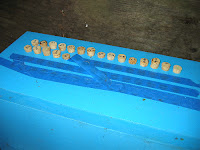Yesterday the eggs hatched. I have found that with the Mann Lake Queen Breeding Device, larvae are usually fed upon hatching, but sometimes neglected after a few hours, so I generally like to remove larvae after their initial feeding but before all the larvae have hatched. I am usually pretty darn lucky and this time was no exception.Neglected larvae are usually in small colonies or if there is incoming nectar shortage, so, in my opinion, the Mann Lake queen device works best with larger-than-nuc sized colonies during an artificial or real nectar flow.
The larvae are in little plastic cups which I then attach to just about anything that will mount easily on a cell bar frame.
This time, tapered corks. Corks work well since you can handle them easily, they’re cheap, and mount easily. They’re reusable and easily sterilized, but bees tend to chew them up. Mann Lake offers cell cup holders and mounts in plastic, they work also.
Next, I place the corks into a swarm box. The box is a modified Marburg Swarm Box.
The commercial one shown here has its funnel open. Two hours earlier Dennis and I collected young bees from one of his hives to stock the swarm box. The box is stocked with frames of pollen, nectar and water. You only want young bees preferably between 5 and 15 days old, since that is when their hypopharangeal glands are really knocking out the royal jelly. The swarm funnel keeps out drones and queens by forcing the bees through a queen excluder.You have to shake about 10 brood frames, not necessarily from the same hive. It is best to leave the queen in her box.
The technique is to give a light shake and let the older bees return to the hive. A good moderate shake and the young bees fall into the funnel. The very youngest bees, just emerged, really hang on tight, so that they get to return to the colony. The young bees in the funnel don’t know where they live and haven't been flying, so they head on in. Drones and virgin queens can’t pass through and can be brushed out, but there are tricks to avoid them even being on the frames.
A couple hours later, and the broodless, queenless, bees are jonesing for something to do and that’s when they get the corks with the freshly hatched larvae. The young bees give the larvae good feed, getting them off to a good start using the Queenless Emergency Impulse. 24 hours later, the well fed larvae were transferred to cell finishing colonies.
I found the picture of a commercial Marburg Box on a Czeck site: VitaVydra's Beekeeping page, XIIIth Convention of Innovators and InternationalBeekeeping Exhibition in Prague 2002























